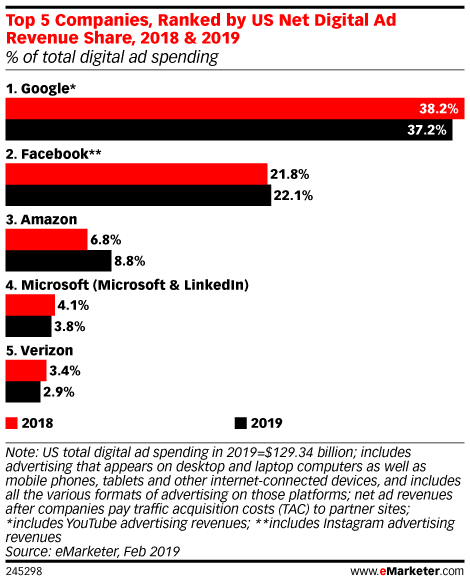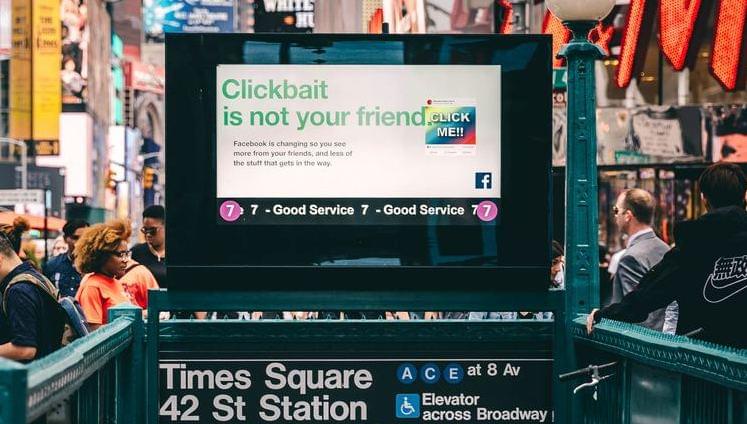This article was created in partnership with Proper Media. Thank you for supporting the partners who make SitePoint possible. Looking to partner with SitePoint? Get more information here.
Recently, there have been countless articles and think pieces written about the decline of publishing. These articles often illustrate how difficult it is for publishers to monetize what they do to eke out a sustainable business model.
In reality, advertising revenue is down for independent publishers across the board. More people are using advanced ad blocking software, which is impacting the number of ads publishers can show. Plus there are two giant elephants in the room — Google and Facebook. These two entities combined account for almost 60% of the total advertising spend online. This duopoly uses third-party publisher content to bring in advertising revenue, but leaves very little revenue for the publishers themselves. For better or worse, they also have the scale to very effectively monetise their user base, which a smaller publisher just can’t compete with. Facebook, for example, has an average CPM of around $8 compared to an average CPM of $1 for third-party publishers. As the online advertising world evolves, publishers will face new obstacles to monetize their websites.

To overcome these difficulties, publishers have all tried different ways to generate revenue in this new landscape; the New York Times and many others have tried to sell premium subscriptions to their users by hiding their content behind paywalls. Another example of subscription-based revenue is Apple News+, which is an attempt to distribute some subscription revenue to publishers, albeit after Apple takes its healthy cut. However, consumers are still very unlikely to pay for content online. A study by Reuters Institute and Oxford University recently found that only 13% of people in the US pay for an ongoing news solution.
Paywalls have worked effectively for some publishers like the New York Times, where they have seen year-on-year revenue growth for their premium subscription product. But this is just not feasible for a lot of others, who are seeing a backlash from users to this system. In addition to being ineffective for many publishers, paywalls are inherently at odds with a publisher’s goals. Publishers want to produce content that educates and informs the largest number of people, which is the opposite of how a paywall operates. With these constraints around subscription-based website monetization, traditional display advertising has remained a large part of overall publisher revenue, including ours.
The simple fact is advertising has always been integral to an online publisher like us—it is how we here at SitePoint keep everything running and pay for our writers to produce interesting content that you come to read. We, like all other businesses, have to generate revenue. We’ve faced the same challenges over the years and the same struggle to strike a balance between generating revenue with advertising (in order to continue to produce a plethora of free, educational content), while creating a user experience that allows our readers to digest and enjoy that content without annoyance. We admittedly do not always get this balance right.
Currently, we’ve teamed up with Proper Media as our programmatic revenue partner, in hopes of finding that balance. The way it works is that we leverage Proper’s header bidding solution to monetize the ad slots on our article pages. Working with Proper allows us to get the highest CPMs by creating competition for our inventory across all the top advertising demand available (e.g. Amazon’s A9, Google Adx, and AOL’s OATH). Additionally, they take care of the direct demand for ad sales. Gone are the days when advertisers bought large advertising blocks from individual publishers — nowadays, it is all run programmatically.
In short, Proper handles the monetization so we can focus on producing great content. They ensure that our ad revenue is as high as possible. They have continuous data-driven optimizations and granular real-time reporting which ensure that we are always getting the best yield for our ad units. They also handle all of the receivables and deliver a consolidated payment that is on faster terms than all major exchanges, which really helps the cash flow of a small publisher like us.
When we asked Proper why they thought SitePoint should work with them, this is what they said, which sums up why we chose them and have stayed with them as our partner in this crowded marketplace.
As publishers ourselves we have a deep operational understanding of what it takes to thrive in this industry. We form such close partnerships that our clients often view Proper’s team as an invaluable extension of their own.
Unlike other ad tech companies, Proper doesn’t lock publishers into long term commitments. In an industry where it is common to continuously test new ad partners, Proper has been able to maintain a very high retention rate because all that matters is making you far more money than anyone else can. Ask our current publishing partners, and they will likely tell you that the results speak for themselves.
The reality for a publishing business at the moment is that we need to monetise our content with advertisements in order to keep producing more content. We chose to work with a programmatic revenue partner so we could remain focused on what we do best: producing content that our readers want to read. The main reasons that we initially chose Proper Media as that programmatic revenue partner are:
- Performance: Proper consistently delivers strong CPMs.
- Rev Share: they have one of the lowest revenue shares in the industry while maintaining a top quality service
- Payment: they consolidate all the payments from different demand partners and they consistently and reliably pay us on time.
- Industry Expertise: they are actually publishers themselves, with Salon.com and TVtropes.org under their wing, so they understand our needs and struggles first-hand.
And the reasons we have stayed are:
- Excellent Customer Service: We can talk with a real person if we have an issue and they will work through the problem with us one-on-one.
- Robust Analytics: The reporting and dashboard are easy to use and provide powerful insights.
- Operational Efficiency: Proper’s team acts as an extension of our own and often prevents us from having to carry the overhead that goes along with a large ad ops and development team that focuses solely on monetization.
- Additional Revenue: over the last 9 months since we partnered with Proper, SitePoint has seen a 5% average increase to our advertising revenue.
Another way SitePoint funds our content is through recommending services and products that we trust and use ourselves. So if you are looking for a new programmatic advertising partner to help monetize your website, we recommend taking a look at what Proper Media has to offer. See if your site qualifies for this website monetization opportunity:
- If your site is already generating at least $10,000 USD in monthly programmatic revenue, then you meet Proper Media’s minimum.
- If your site generates less than $10,000 USD per month, Proper still might be a good fit, but there would be a minimum monthly fee to consider.
If you are looking for a better way to generate revenue for your site, we recommend giving Proper a try. Also, as a SitePoint reader, if you sign up now Proper Media will waive its first month of revenue share! Just sign up here or reference “SitePoint” during onboarding with Proper Media.
 Kishen Kaurah
Kishen KaurahKishen is a former management consultant and product manager, who has been tinkering with digital products for as long as he can remember. He is the General Manager of SitePoint and is working on developing a new learning experience for users of SitePoint Premium.





